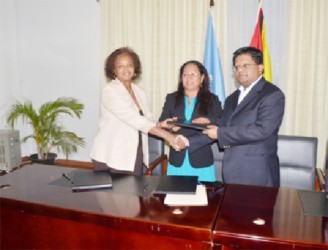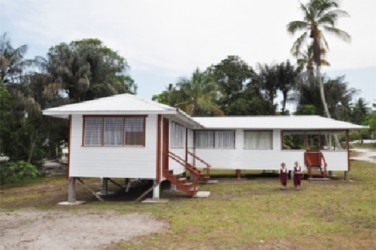Over 160 Amerindian communities are expected to benefit from access to funding to support their development with the signing of a $1.3 billion agreement between the government and the United Nations Development Programme (UNDP) on Thursday.
Minister of Finance Dr. Ashni Singh, Minister of Amerindian Affairs Pauline Sukhai and UNDP Resident Representative and UN Coordinator Khadija Musa signed the agreement at the Guyana International Conference Centre to facilitate Phase II of the Low Carbon Development Strategy (LCDS) Amerindian Development Fund (ADF) Project.
Under the project, funded through the Guyana REDD+ Investment Fund (GRIF) and overseen by the Project Management Office in the Office of the President, funding would be provided to support the socio-economic development of the Amerindian communities and villages through the implementation of their Community Development Plans (CDPs).

According to a Govern-ment Information Agency (GINA) report, communities will receive funding of up to $5M each for each village’s development of a community-based project. All CDPs are approved by consensus or majority vote at village meetings, governed by Section 32 of the Amerindian Act of 2006. The UNDP is providing technical support to the project, including, administration of social, fiduciary and environmental safeguards, the report noted.
GINA reported that during Phase I of the ADF project, 26 communities received disbursements, amounting to approximately $112 million in total, to implement their respective CDPs.
According to GINA, examples of CDPs implemented in Phase I, include the construction of a guest house at Santa Aratack; and the rehabilitation of a Multi-Purpose Centre at Moraikobai, for which sewing machines, computers and a printer, stove, freezer and kitchen utensils were also acquired.
The report added that there were several villages that focused on agriculture in Phase I, including Kurukubaru in Region Eight, where funding went to cattle rearing. “This saw the completion of the construction of a ranch house and corral along with the purchase of a horse and cattle along with medications,” it said. In Rupertee village in Region Nine, five acres of cassava has been cultivated and a processing facility completed, it added.
GINA said Phase I is nearing completion and Phase II of the project will now begin with the first set of activities to include engaging with the communities to finalise their CDPs. It was noted that lessons learned from Phase I have been recorded in the Phase II project documentation and will help to optimise project execution.
‘Committed’
At the signing, Finance Minister Dr Ashni Singh drew attention to the fact that Guyana has forgone development for centuries in acting responsibly, in preserving its natural environment, and for that he said tribute must be paid to Amerindian leaders who spearheaded this effort long before the world woke up to the reality of climate change.

Singh noted that the ADF is among a number of projects for implementation with the proceeds of the Norway payments for environmental services. He also mentioned the Amerindian Land titling project, the small and medium sized enterprises project, the climate resilient strategy and action plan project, institutional strengthening project to bolster the institutions involved in environmental management and the Amaila Falls hydropower project, which was described as the flagship project of the LCDS.
“We are committed to realising all of these projects, including Amaila; we are committed to working with all of our partners, firstly with Norway, in ensuring that we discharge our obligations. We are particularly pleased with the development agencies that have been working with us. The UNDP has been an outstanding partner…,” Singh was quoted as saying by GINA.
“It is our expectation that during the course of the remainder of this year and next year, these projects will see their full implementation,” he further said, having noted that such initiatives being implemented in partnership with agencies will feature very prominently in next year’s budget.
Meanwhile, GINA reported Sukhai as saying that the release of the funds is an important landmark for Guyana. She however, noted that the projects which began during the first phase are still ongoing, with the exception of the ‘Santac Tours and Travel’ project at the Santa Aratack Village, in Region Three, which was recently launched.
She also noted that the success of any project depends on support which comes from various corners and towards this end she suggested that the villagers should move to build partnerships to help in the sustainability of their projects.
Also speaking at the signing was Musa, who pointed out that the programme came after a year of intense work. She noted that there was a pilot phase, from which mistakes were recognised and what was learnt was incorporated into the bigger projects.
Musa said that work was conducted in total partnership during visits to communities and that there could be an exchange of knowledge among communities. She also commended the work done at Santa Aratack Village, which she called outstanding, the GINA report said.




